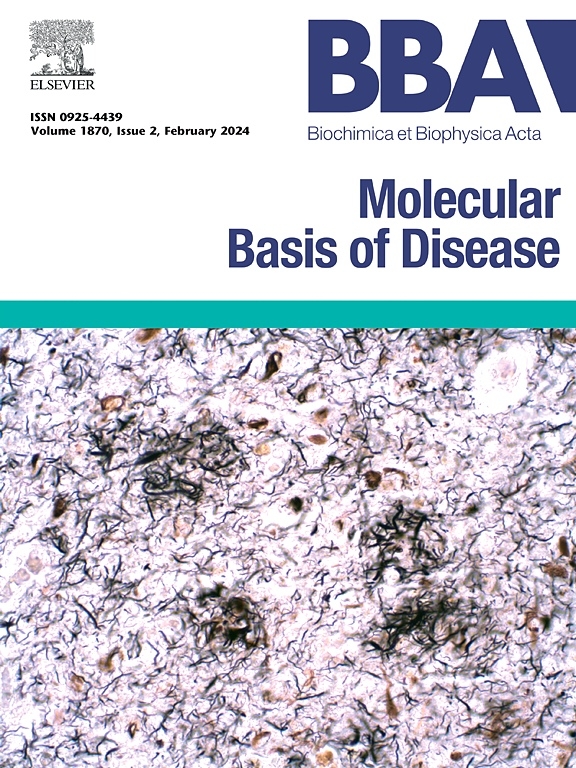IL-10 signaling modulates PRKN methylation and influences STAT3 activity to drive regulatory macrophage differentiation
IF 4.2
2区 生物学
Q2 BIOCHEMISTRY & MOLECULAR BIOLOGY
Biochimica et biophysica acta. Molecular basis of disease
Pub Date : 2024-12-27
DOI:10.1016/j.bbadis.2024.167643
引用次数: 0
Abstract
The pathogenesis of many immune disorders is linked to regulatory macrophage dysfunction. The mechanism underlying it is unclear. The objective of this study is to examine the mechanism by which the PRKN ubiquitin protein ligase (PRKN) inhibits the development of regulatory macrophages (Mreg). In this study, dust mite antigens were used as the specific allergens to establish an airway allergy (AA) mouse model. Flow cytometry cell sorting was used to isolate macrophages from the airway tissues. According to the results, the Prkn gene inhibition led to an increase in the number of Mregs in macrophages. Mregs demonstrated the capacity to suppress Th2 polarization, in which IL-10 played a critical role. Pan macrophages isolated from Prkn-deficient mice were more capable of suppressing the activities of other immune cells. PRKN was required for maintaining the hyperubiquitous status of signal transducer and transcriptional activator-3 (STAT3) in macrophages. Exposure to dust mite antigen increased the expression of PRKN in macrophages. IL-10 suppressed PRKN in macrophages by inducing its promoter hypermethylation. PRKN inhibition mitigated the experimental AA. To sum up, PRKN maintains the hyper ubiquitous status of STAT3 and restricts the expression of IL-10 in macrophages, which compromises their immune suppressive functions. Inhibition of PRKN increases Mreg development and mitigates AA. The data suggest that the regulation of Mreg has translation potential to be used in the treatment of immune disorders such as AA.
IL-10信号调节PRKN甲基化并影响STAT3活性,驱动调节性巨噬细胞分化。
许多免疫疾病的发病机制与调节性巨噬细胞功能障碍有关。其背后的机制尚不清楚。本研究的目的是研究PRKN泛素蛋白连接酶(PRKN)抑制调节性巨噬细胞(Mreg)发育的机制。本研究以尘螨抗原作为特异性变应原,建立气道变态反应(AA)小鼠模型。采用流式细胞术细胞分选分离气道组织巨噬细胞。结果显示,Prkn基因抑制导致巨噬细胞中Mregs数量增加。Mregs显示出抑制Th2极化的能力,其中IL-10发挥了关键作用。从prkn缺陷小鼠中分离的Pan巨噬细胞更能抑制其他免疫细胞的活性。PRKN是维持巨噬细胞中信号换能器和转录激活因子-3 (STAT3)超普遍状态所必需的。暴露于尘螨抗原后,巨噬细胞中PRKN表达增加。IL-10通过诱导其启动子超甲基化抑制巨噬细胞中的PRKN。抑制PRKN可减轻实验性AA。综上所述,PRKN维持了STAT3的超泛在状态,限制了巨噬细胞中IL-10的表达,损害了巨噬细胞的免疫抑制功能。抑制PRKN可增加Mreg的发展并减轻AA。这些数据表明,Mreg的调控具有翻译潜力,可用于治疗AA等免疫疾病。
本文章由计算机程序翻译,如有差异,请以英文原文为准。
求助全文
约1分钟内获得全文
求助全文
来源期刊
CiteScore
12.30
自引率
0.00%
发文量
218
审稿时长
32 days
期刊介绍:
BBA Molecular Basis of Disease addresses the biochemistry and molecular genetics of disease processes and models of human disease. This journal covers aspects of aging, cancer, metabolic-, neurological-, and immunological-based disease. Manuscripts focused on using animal models to elucidate biochemical and mechanistic insight in each of these conditions, are particularly encouraged. Manuscripts should emphasize the underlying mechanisms of disease pathways and provide novel contributions to the understanding and/or treatment of these disorders. Highly descriptive and method development submissions may be declined without full review. The submission of uninvited reviews to BBA - Molecular Basis of Disease is strongly discouraged, and any such uninvited review should be accompanied by a coverletter outlining the compelling reasons why the review should be considered.

 求助内容:
求助内容: 应助结果提醒方式:
应助结果提醒方式:


